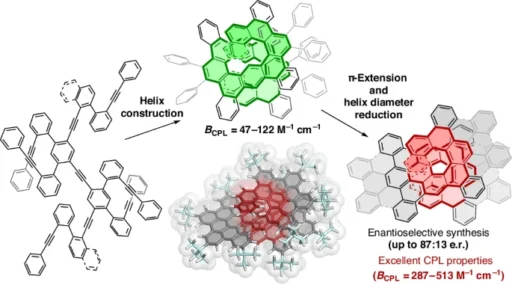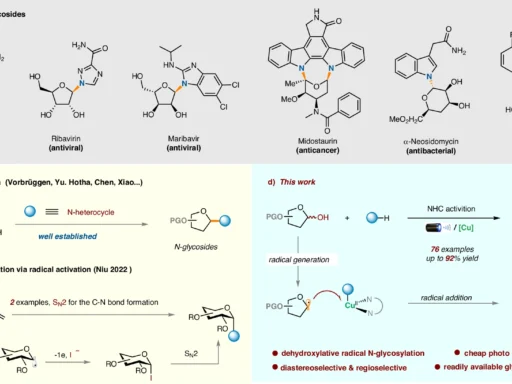Table of Contents
Overview
Carbohelicenes have attracted researchers due to their distinctive helical arrangement of aromatic rings and fascinating photophysical characteristics. Researchers have focused their recent progress on enhancing these substances’ circularly polarized luminescence (CPL). This in-depth study is all about making three-dimensional π-extended carbohelicenes and choosing the right ones to use in circularly polarized luminescence (CPL) These substances are circularly polarized luminescence (CPL).
An Exploration into Carbohelicenes:
What are Carbohelicenes?:
Carbohelicenes are a class of organic compounds characterized by their unique helical structure.
Carbohelicenes are polycyclic aromatic hydrocarbons with a distinct helical molecular structure. These compounds possess chirality and exhibit unique optical properties, which makes them fascinating candidates for investigation in diverse domains.
The significance of 3D π-extension in carbohelicenes:
The expansion of the π-system in three dimensions is crucial to improving the photophysical characteristics of carbohelicenes. This lengthening makes it easier for electrons to move between aromatic rings, which leads to more circularly polarized luminescence (CPL) signals and better sensitivity in chiral recognition.
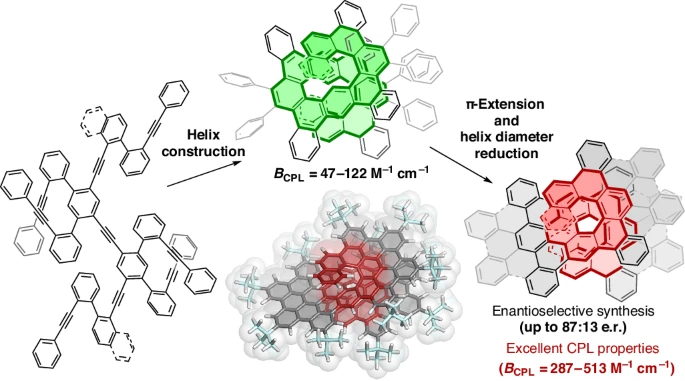
Circularly Polarized Luminescence (CPL):
Definition and Significance:
The phenomenon known as Circularly Polarized Luminescence (CPL) occurs when a material emits light with a specific polarization direction. It is significant because it provides valuable information on the material’s electronic and structural properties.
Circularly polarized luminescence (CPL) is the emission of light with a preferred polarization direction. This phenomenon is highly intriguing because of its pertinence in disciplines like materials science, optoelectronics, and biological imaging. CPL offers a significant understanding of molecular chirality and aids in the production of sophisticated functional materials.
Applications of CPL:
Practical uses of complementary metal-oxide semiconductor (CMOS) programmable logic (CPL) technology.
CPL has a wide range of applications in several domains, such as chiral sensing, display technology, and molecular imaging. CPL-based methods are very useful for finding specific chiral compounds and are used a lot in asymmetric synthesis, medicinal research, and environmental monitoring.
Importance of Enantioselective Synthesis:
The Significance of Chirality in Circularly Polarized Luminescence (CPL):
Chirality is essential in CPL, as enantiomeric compounds display unique CPL signals. To fully utilize CPL’s capabilities in real-world scenarios, it is critical to create carbohelicenes that are enantiomerically pure and have fine control over their stereochemistry.
Difficulties in Achieving Enantiomerically Pure Carbohelicenes:
Producing carbohelicenes with a single enantiomer is extremely difficult because of the complex chemical structure and the need for a high degree of enantioselectivity. Conventional synthetic methods frequently produce mixes of molecules with equal amounts of both enantiomers or with low levels of one enantiomer, requiring the development of new approaches to manage stereochemistry.

Design strategies for 3D π-extended carbohelicenes:
considerations for molecular design:
The construction of 3D-extended carbohelicenes necessitates the careful analysis of the chemical structure to maximize Π-conjugation while maintaining chirality. The exact placement of substituents and functional groups makes it possible to finetune the electrical properties and boosts the efficiency of circularly polarized luminescence (CPL).
The significance of extended π-systems:
The three-dimensional expansion of the π-system makes it easier for the π-orbitals of adjacent aromatic rings to overlap. This improves energy transfer and makes circularly polarized luminescence emission stronger. The elongated conjugation pathway improves the molecular structure’s stability and rigidity, thereby increasing CPL’s performance.
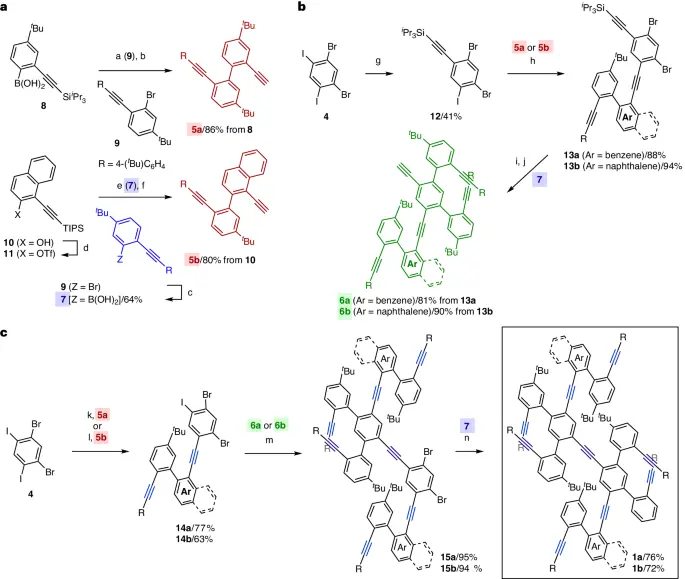
Methods for the Synthesis of Enantiomerically Pure Compounds:
Synthetic route overview:
Researchers have developed a variety of methods to synthesize carbohelicenes that selectively produce one enantiomer. These methods include transition metal-catalyzed processes, stereoselective cyclizations, and asymmetric transformations. These approaches provide different levels of effectiveness, specificity, and scalability, tailored to the specific needs of target applications.
The Significance of Stereocontrol:
Attaining high degrees of enantiomeric purity is of the utmost importance in enantioselective synthesis, with accurate stereocontrol being the key factor. Chiral catalysts, ligands, and auxiliaries are essential for controlling the stereochemical results of important synthetic reactions, allowing the production of single enantiomer products with great accuracy.
Methods of experimentation:
Characterization Methods:
Methods for characterizing or analyzing the properties and qualities of a subject.
Several spectroscopic methods, including nuclear magnetic resonance (NMR) spectroscopy, mass spectrometry, and X-ray crystallography, are used to study the structure and stereochemistry of the carbohelicenes that are made. These analytical methods offer indispensable insights into the molecular structure, spatial arrangement, and level of impurities.
Techniques for CPL Measurement:
CPL characteristics are evaluated using specialized spectroscopic instruments that can detect the emission of circularly polarized light. Some techniques, like circular dichroism (CD) spectroscopy, fluorescence spectroscopy, and time-resolved CPL measurements, make it possible to measure CPL intensity, dissymmetry factor, and emission spectra with great accuracy. These techniques provide valuable insights into the underlying photophysical phenomena.
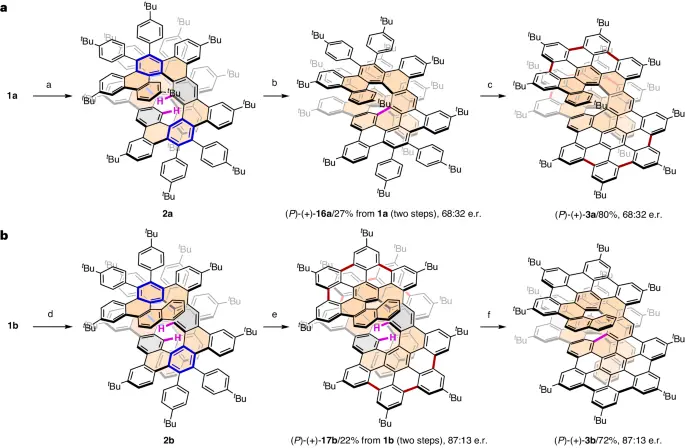
Uses of 3D π-Extended Carbohelicenes:
Because of their unique photophysical properties and chiral features, 3D π-extended carbohelicenes have a lot of potential in a wide range of applications.
Organic electronics:
These compounds are very suitable for use in organic light-emitting diodes (OLEDs), organic field-effect transistors (OFETs), and organic photovoltaics (OPVs). Their exceptional efficiency in circularly polarized luminescence (CPL) and electron transport characteristics significantly improve these devices’ performance and stability.
Chiral Sensing:
The process of chiral sensing uses 3D-extended carbohelicenes to selectively recognize and detect chirality. These carbohelicenes are well-suited for chiral sensing applications due to their ability to specifically identify and distinguish between different chiral molecules. Because they can quickly and effectively respond to outside influences and because their electronic and optical properties can be changed, it is possible to make very sensitive and specific sensors that are used in biomolecular detection, monitoring the environment, and analyzing drugs.
Asymmetric catalysis:
In asymmetric transformations, carbohelicenes can function as highly adaptable chiral catalysts. They facilitate the production of enantioenriched compounds with a high degree of stereoselectivity. Their distinct molecular structure creates an asymmetrical environment that promotes catalytic reactions, opening up new possibilities for producing intricate natural compounds, pharmacological building blocks, and high-quality chemicals.
Current advancements and upcoming trajectories:
The field of 3D π-extended carbohelicenes has made significant progress due to recent breakthroughs in synthetic techniques, computational modeling, and material characterization.
Methods of synthesis:
New ways of making things, like cascade reactions, tandem catalysis, and dynamic kinetic resolutions, are now useful for making many different carbohelicene structures more quickly and precisely, while also giving us more control over their stereochemistry. These approaches provide novel prospects for swiftly identifying and refining CPL-active compounds with customized characteristics.
Analysis of Materials:
Spectroscopic techniques, microscopy, and computer modeling have made it possible to look closely at how the structure and properties of 3D π-extended carbohelicenes are related. Molecular dynamics simulations, density functional theory (DFT) calculations, and exciton coupling studies help us learn a lot about the photophysical rules that control the behavior of circularly polarized luminescence (CPL). These insights can guide the systematic design of advanced materials with exceptional performance.
Emerging Applications:
The growing collection of 3D π-extended carbohelicenes has generated enthusiasm for their potential use in various fields, including bioimaging, chiral photonics, and quantum information processing. These materials have promising prospects for multidisciplinary study and technological advancement, with possible uses in various fields such as molecular sensors, light-emitting devices, quantum cryptography, and information storage.
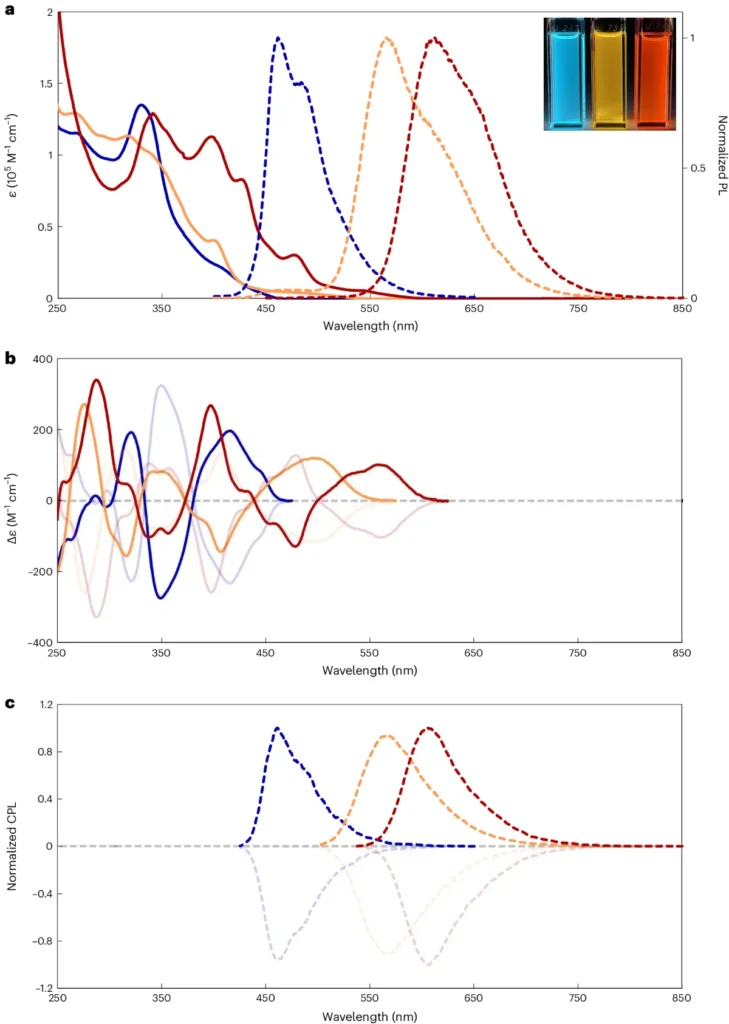
In conclusion:
The creation and selective production of 3D π-extended carbohelicenes is a noteworthy achievement in the search for new materials that exhibit circularly polarized luminescence. These compounds demonstrate exceptional photophysical characteristics and have great potential in various applications, including organic electronics, chiral sensing, and asymmetric catalysis. Through the strategic combination of molecular design, synthetic chemistry, and material characterization, researchers are on the verge of discovering new possibilities in CPL research. This will lead to the development of groundbreaking technologies that will have a significant influence on society.
Frequently Asked Questions:
1). Why is circularly polarized luminescence important?
Circularly polarized luminescence (CPL) provides valuable information about molecular chirality and finds applications in diverse fields like materials research, bioimaging, and optoelectronics.
2). What is the mechanism by which 3D π-extended carbohelicenes enhance circularly polarized luminescence (CPL)?
The three-dimensional expansion of the π-system makes it easier for aromatic rings to communicate electronically. This leads to more circularly polarized luminescence (CPL) emission and better chiral recognition.
3). What challenges are associated with the enantioselective synthesis of carbohelicenes?
To make enantiomerically pure carbohelicenes, complicated synthetic methods, and chiral catalysts must be used along with precise stereocontrol.
4). What are some uses of 3D π-extended carbohelicenes?
Organic electronics, chiral sensing, and asymmetric catalysis utilize 3D-extended carbohelicenes due to their unique photophysical capabilities and chiral characteristics.
5). What are the possible future trajectories in this field?
Future research could prioritize the development of innovative synthetic techniques, the investigation of new applications in emerging domains, and the improvement of our understanding of the connection between molecular structure and CPL.
For more chemistry blogs, visit chemistry Master

